Dissecting The Double-Speak: A Critical Look At Trump's Transgender Military Policy

Table of Contents
The Policy's Evolving Narrative: A Timeline of Contradictions
Initial Announcement and Justification
The initial justification for the ban, largely disseminated via Twitter and press releases, lacked concrete evidence. Claims focused on concerns about military readiness and the supposed costs associated with transgender healthcare. However, these claims were largely unsubstantiated and contradicted by existing military data.
- Contradictory Statements: Trump's pronouncements often shifted, sometimes citing concerns about “tremendous medical costs” while other times focusing on perceived disruptions to military cohesion and readiness. These statements lacked consistent supporting evidence.
- Unfounded Claims: The administration claimed that transgender service members would pose a burden on military readiness and negatively impact unit cohesion. These claims were widely refuted by experts and lacked empirical support. Numerous studies demonstrate that transgender individuals serve effectively and do not negatively affect military readiness.
Legal Challenges and Court Battles
The ban immediately faced significant legal challenges. Numerous lawsuits were filed by LGBTQ+ rights organizations and individual service members, arguing that the policy violated their constitutional rights.
- Key Court Cases: Cases like Doe v. Trump and subsequent rulings consistently challenged the legality and rationale behind the ban, leading to temporary injunctions and ultimately, a reversal of the policy.
- Prominent Figures and Organizations: The ACLU, Lambda Legal, and numerous other organizations played crucial roles in leading the legal fight against the discriminatory policy, representing service members impacted by the ban.
The Shifting Rhetoric: How the Justification Changed Over Time
The administration's justification for the ban evolved (or rather, shifted inconsistently) over time, often in response to mounting legal and public pressure. This lack of coherent reasoning further exposed the policy’s questionable foundation.
- Examples of Shifting Statements: Initial arguments focusing on medical costs gradually shifted to concerns about “unit cohesion,” a claim which remained largely undefined and unsupported.
- Lack of Transparency and Consistency: The inconsistent messaging surrounding the policy highlighted a lack of transparency and a deliberate attempt to obfuscate the true motivations behind the ban.
The Human Cost: Impacts on Transgender Service Members
Loss of Service and Career Disruption
The ban had devastating consequences for transgender individuals already serving or aspiring to serve in the military. Many were discharged, their careers abruptly ended, leaving them facing significant financial and emotional hardship.
- Examples of Service Members Discharged: Numerous accounts emerged of highly qualified and dedicated service members facing discharge solely due to their gender identity, demonstrating the devastating impact of the policy.
- Psychological and Financial Toll: The emotional distress caused by the ban, coupled with the loss of income and healthcare benefits, resulted in significant hardship for many affected individuals.
Impact on Recruitment and Retention
Trump's transgender military policy negatively affected the military's ability to recruit and retain highly qualified personnel. The policy created a climate of fear and uncertainty, deterring qualified transgender individuals from even considering military service.
- Statistics on Enlistment Rates and Attrition: While precise figures are difficult to isolate, anecdotal evidence and expert analysis suggest a decline in the recruitment and retention of transgender individuals.
- Loss of Valuable Skills and Experience: The exclusion of transgender individuals deprived the military of a valuable pool of talent and experience, negatively impacting overall readiness and capabilities.
The Broader Impact on LGBTQ+ Inclusion
The policy had a chilling effect on the morale and inclusivity of the entire military, sending a negative message to all LGBTQ+ service members. It fueled concerns about discrimination and harassment, undermining efforts to foster a more inclusive environment.
- Effects on the Overall Climate for LGBTQ+ Service Members: The ban created a sense of vulnerability and uncertainty amongst LGBTQ+ service members, fostering a climate of fear and discouraging open communication.
- Increased Discrimination and Harassment: While precise figures are difficult to quantify, the policy likely exacerbated existing discrimination and harassment faced by LGBTQ+ service members.
The Policy's Legal and Ethical Ramifications
Violation of Constitutional Rights
The ban was widely criticized for violating the constitutional rights of transgender individuals to equal protection and due process under the law. The policy was seen as discriminatory and arbitrary, targeting a specific group based on their gender identity.
- Relevant Legal Precedents and Constitutional Amendments: Arguments against the ban drew upon the Equal Protection Clause of the Fourteenth Amendment and established legal precedent protecting against discrimination based on sex and gender identity.
- Expert Opinions on the Legal Challenges: Numerous legal experts and organizations argued that the policy violated established legal principles and was unconstitutional.
Ethical Considerations
Excluding transgender individuals from military service based on prejudice and outdated ideas about gender identity raises significant ethical concerns. The policy was fundamentally unjust and discriminatory.
- Arguments Against Discrimination Based on Gender Identity: The ethical argument centers on the principle of equal opportunity and the rejection of discrimination based on immutable characteristics like gender identity.
- Ethical Frameworks That Contradict the Policy: Numerous ethical frameworks, including those emphasizing human dignity, fairness, and justice, clearly contradict the discriminatory nature of Trump's transgender military policy.
Conclusion: Understanding the Lasting Impact of Trump's Transgender Military Policy
Trump's transgender military policy was marked by contradictions, inflicted significant human cost, and raised serious legal and ethical concerns. The policy's inconsistent justifications, its devastating impact on transgender service members, and its violation of fundamental rights highlight the dangers of discriminatory policies based on prejudice. The long-term consequences include damage to the military’s reputation for inclusivity, a loss of talent, and lasting trauma for those directly affected. Understanding the complexities of Trump's transgender military policy is crucial to ensuring a more just and equitable future for transgender individuals in the military. Continue to engage with this critical conversation and support organizations fighting for LGBTQ+ rights, working towards a military that reflects the diversity of our nation and embraces all qualified individuals regardless of gender identity.

Featured Posts
-
 Madhyamik 2025 Merit List Analysis Of Top Performers And Trends
May 10, 2025
Madhyamik 2025 Merit List Analysis Of Top Performers And Trends
May 10, 2025 -
 Ray Epps Sues Fox News For Defamation Jan 6th Claims At The Center Of Lawsuit
May 10, 2025
Ray Epps Sues Fox News For Defamation Jan 6th Claims At The Center Of Lawsuit
May 10, 2025 -
 Lightning Defeat Oilers 4 1 Behind Kucherovs Strong Performance
May 10, 2025
Lightning Defeat Oilers 4 1 Behind Kucherovs Strong Performance
May 10, 2025 -
 Palantirs Q1 2024 Results A Deep Dive Into Government And Commercial Performance
May 10, 2025
Palantirs Q1 2024 Results A Deep Dive Into Government And Commercial Performance
May 10, 2025 -
 Jeanine Pirro And Due Process Concerns Over El Salvador Prison Transfers
May 10, 2025
Jeanine Pirro And Due Process Concerns Over El Salvador Prison Transfers
May 10, 2025
